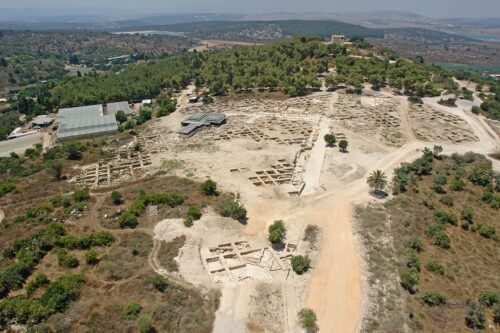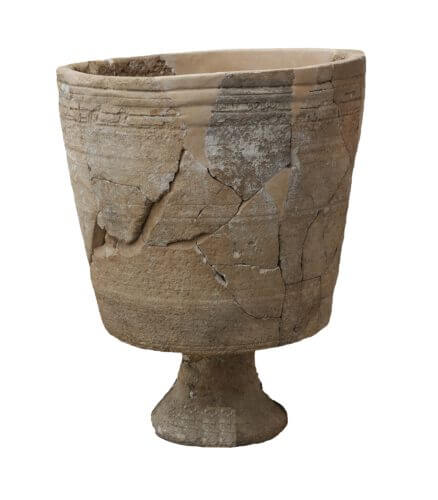They did not let the great disaster affect their lives * With the suppression of the great revolt by the Romans and the fall of Jerusalem in 70 AD, the Roman army destroyed the temple. The Jewish inhabitants who remained in the land shaped their religious way of life with an affinity to the temple, but without direct dependence on it. In a study carried out by researchers at the Hebrew University in Jerusalem and focused on the city of Tzipori, it was discovered that the Jews who lived there observed the customs of purity for many years and that Jewish life in the city flourished after the Holocaust

A recently published study offers fascinating insights into the question of how Jewish life continued in the Land of Israel, following the destruction of the Second Temple by Titus and the Romans and after the Bar Kochba Rebellion (the second rebellion of the Jewish people that took place in the Land of Israel between 135-132 AD, against the Roman Empire). According to what we know, after the failure of the Great Revolt and at the beginning of the second century AD, the position of Zipuri, the Jewish city in the center of the Galilee, strengthened, and after the Bar Kochba Revolt, it became the center of a fruitful and vibrant Jewish life, at a time when many sages lived there. At the end of the second century AD, Rabbi Yehuda the Hanasi and his Jewish leadership institutions uprooted their seat in Beit Shaarim and moved to Tzipori, the capital of the Jewish Galilee.
According to new findings discovered at Zipori, a site excavated in recent decades by several excavation teams and mainly by a delegation of researchers from the Hebrew University of Jerusalem, the use of different tools made of limestone (Kirton limestone cut from soft carbonate rock) which was very common among the Jewish population during the Second Temple period, did not stop With the destruction of Jerusalem and Judea in the first half of the second century AD as previously thought, but continued in the Galilee - the new center of Jewish life in Israel at that time, for at least two more centuries.
In a study published in the journal Bulletin of the American Schools of Oriental Research (BASOR), which was led by Mia Sherman and Prof. Zeev Weiss from the Institute of Archeology at the Hebrew University, many fragments of tools were found in the birds that were made of limestone in various excavation areas, mainly in the lower city. Among other things, bowls, cups, mugs, goblets, trays, lids for jugs, carters (a large vessel with a barrel body, a wide opening and a shaped foot), bottle caps and more were found. Some had engravings and some were found without decorations. The most surprising item was a crater that remained intact and that was discovered together with agricultural tools in the fill of the earth, which covered the farm house that was built near the city, in light of the archaeological find in the third century AD, and was destroyed during the fourth century AD.

In a geochemical analysis of the tools (testing the compositions of the oxygen and carbon isotopes in the limestone), which was done by Tami Zilberman and Gal Yassour from the Israel Geological Survey, it was possible to understand that a significant part of them was produced in local quarries that operated in the Lower Galilee region. In order to assess whether the tools in Zipori were mostly or at least partly produced in the Galilee or Jerusalem, geochemical samples were also taken from two quarries in the Jerusalem area (Hizma and Mount Scopus). This comparison proved that 80% of the tools tested from Tzipori indicated that the soft limestone from which the tools were made was from the Galilee region and not from Jerusalem. "Two of them are located not far from the city - one is located in Bethlehem of Galilee and the other is located near the village of A-Rayna at the foot of Mount Yona, not far from Nazareth," explains Prof. Weiss. Although we do not have clear evidence for the production of tools in this area even in the later period, according to him, it is logical to think that local workshops operated in the Lower Galilee at least until the third century AD.
The most accepted interpretation that limestone vessels were common during the Second Temple period is related to the Jewish laws of purity, when with the destruction of the temple the interest in them decreased. According to these laws, stone vessels, unlike pottery, did not receive impurity in them. However, the people who lived in Tzipori continued to use them after the destruction of the temple and therefore observed the laws of purity, as is evident from the new findings. In addition, the stone tools were found with many mikva birds that were used at that time. The distribution of the mikvahs in most of the excavation areas in Tzipori, including in the lower city, serve as further evidence of the prominent presence of the Jews there.
"At the sites in Judea that were destroyed by the Romans after the Bar Kochba rebellion, Jewish life stopped completely, and therefore no late evidence of the use of these stone tools was found there. On the other hand, in the Galilee and especially in Zipori, one of the main cities in the Galilee in those days, it seems that life continued on its regular course, and there was no evidence that the local residents suffered as a result of the suppression of the rebellion in Judea," Prof. Weiss concludes. "Among the Jews of Tzipori there were those who continued to maintain the customs of purification at least until the beginning of the fourth century CE, evidence of this can be found in the stone vessels and purification bowls found throughout the site."
More of the topic in Hayadan:
- Economy AI 23: How did the Jews in the land in the Roman period monitor fairness in trade?
- AI economy up to the Middle Ages 14: A wise farmer knows
- Yodafat in front of Jerusalem - who copied from whom if at all? / Dr. Yechiam Sorek
- The remains of the Jewish village of Shekhin near Tzipori were found

2 תגובות
Tzipori was indeed called by modern researchers the "Capital of the Galilee". However, it is worth noting that the term capital city is a consequence of the national movements in the 19th century and any similar attempts are a historical projection. Tzipori was indeed a large settlement center especially after the rebellion of Ben Khosva. I believe that the number of Jewish centers after the Great Revolt resulted from the presence of Roman control, such as Bivna (Yamnia), Bitar, Tzipuri (Diocsaria), Tiberias, Osha and Beit Shaarim, which were near Roman control centers for clear and understandable reasons related to close Roman supervision. A somewhat contrasting second "capital" in the presence of my bird was Tiberias, the seat of Rabbi Yochanan bar Nafcha, one of the pillars of the Jerusalem Talmud.
Why did the Jewish settlement not succeed?
"To return the crown" after the destruction?
paid a price
Learn who they are dealing with
And they had all the time in the world
to recover and rebuild a Jewish empire...